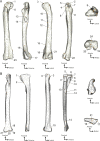Femora from an exceptionally large population of coeval ornithomimosaurs yield evidence of sexual dimorphism in extinct theropod dinosaurs
- PMID: 37309177
- PMCID: PMC10264075
- DOI: 10.7554/eLife.83413
Femora from an exceptionally large population of coeval ornithomimosaurs yield evidence of sexual dimorphism in extinct theropod dinosaurs
Abstract
Sexual dimorphism is challenging to detect among fossils due to a lack of statistical representativeness. The Angeac-Charente Lagerstätte (France) represents a remarkable 'snapshot' from a Berriasian (Early Cretaceous) ecosystem and offers a unique opportunity to study intraspecific variation among a herd of at least 61 coeval ornithomimosaurs. Herein, we investigated the hindlimb variation across the best-preserved specimens from the herd through 3D Geometric Morphometrics and Gaussian Mixture Modeling. Our results based on complete and fragmented femora evidenced a dimorphism characterized by variations in the shaft curvature and the distal epiphysis width. Since the same features vary between sexes among modern avian dinosaurs, crocodilians, and more distant amniotes, we attributed this bimodal variation to sexual dimorphism based on the extant phylogenetic bracketing approach. Documenting sexual dimorphism in fossil dinosaurs allows a better characterization and accounting of intraspecific variations, which is particularly relevant to address ongoing taxonomical and ecological questions relative to dinosaur evolution.
Keywords: 3D geometric morphometrics; dinosaurs; evolutionary biology; intraspecific variation; limb bones; sexual dimorphism.
© 2023, Pintore et al.
Conflict of interest statement
RP, RC, AH, RA No competing interests declared
Figures








Update of
Comment in
- doi: 10.7554/elife.89158
References
-
- Adams DC, Otárola-Castillo E, Paradis E. Geomorph: An R package for the collection and analysis of geometric morphometric shape data. Methods in Ecology and Evolution. 2013;4:393–399. doi: 10.1111/2041-210X.12035. - DOI
-
- Allain R, Vullo R, Rozada L, Anquetin J, Bourgeais R, Goedert J, Lasseron M, Martin JE, Pérez-García A, De Fabrègues CP, Royo-Torres R, Augier D, Bailly G, Cazes L, Despres Y, Gailliègue A, Gomez B, Goussard F, Lenglet T, Vacant R, Tournepiche JF. Vertebrate Paleobiodiversity of the Early Cretaceous (Berriasian) Angeac-Charente Lagerstätte (southwestern France): Implications for continental faunal turnover at the J/K boundary. Geodiversitas. 2022;44:683–752. doi: 10.5252/geodiversitas2022v44a25. - DOI
Publication types
MeSH terms
LinkOut - more resources
Full Text Sources

